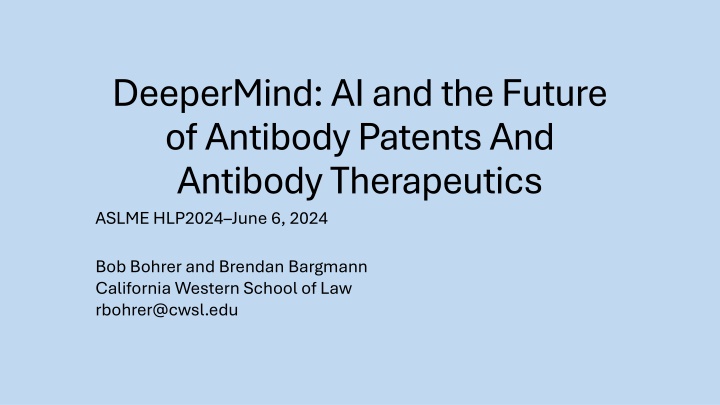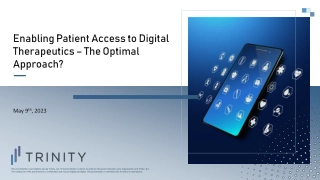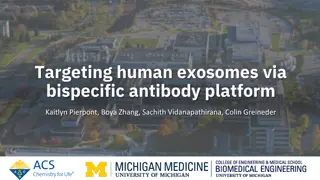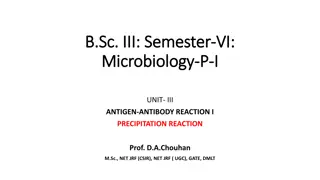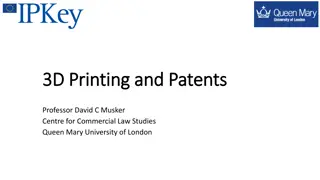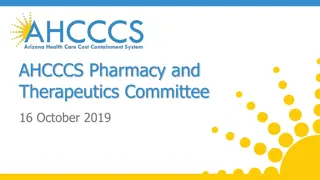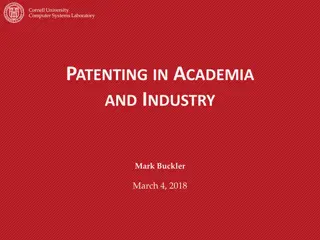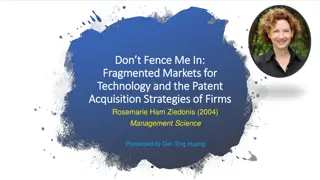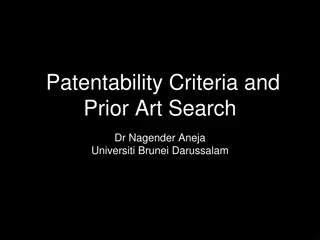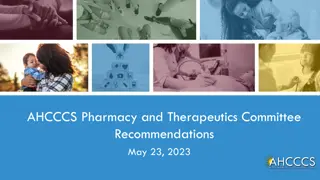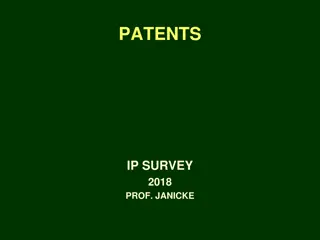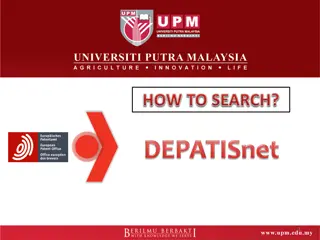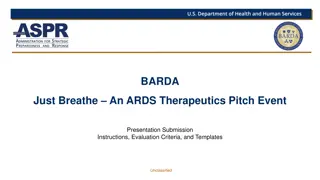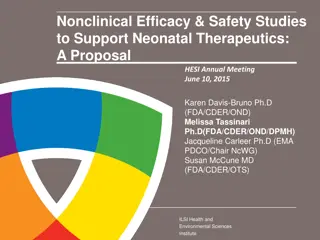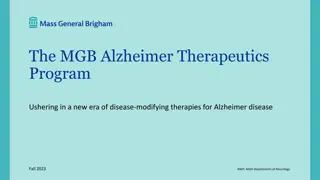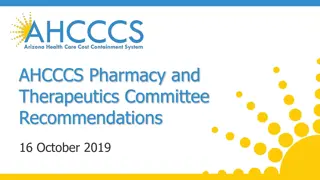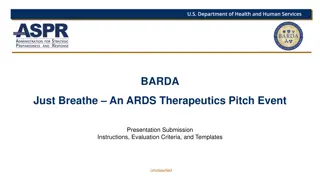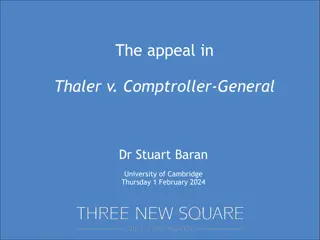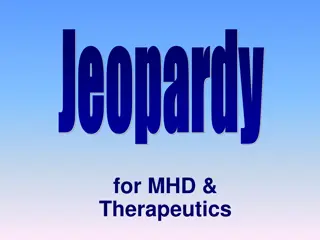Future of Antibody Patents & Therapeutics
Antibody patents and development are evolving with the integration of AI technologies like Meta.AI and DeepFold. Understanding the challenges and opportunities in antibody therapeutics leads to advancements in pharmaceutical innovation and patent regulations regarding antibody claims.
Download Presentation

Please find below an Image/Link to download the presentation.
The content on the website is provided AS IS for your information and personal use only. It may not be sold, licensed, or shared on other websites without obtaining consent from the author.If you encounter any issues during the download, it is possible that the publisher has removed the file from their server.
You are allowed to download the files provided on this website for personal or commercial use, subject to the condition that they are used lawfully. All files are the property of their respective owners.
The content on the website is provided AS IS for your information and personal use only. It may not be sold, licensed, or shared on other websites without obtaining consent from the author.
E N D
Presentation Transcript
DeeperMind: AI and the Future of Antibody Patents And Antibody Therapeutics ASLME HLP2024 June 6, 2024 Bob Bohrer and Brendan Bargmann California Western School of Law rbohrer@cwsl.edu
WHAT THIS TALK IS ABOUT Part I Antibodies and the CAFC s decision in Amgen v. Sanofi. Antibody Therapeutics in cancer, rheumatology, infectious disease, cardiovascular disease. The antibody paradox enablement, written description, and possession. Part II How AI [Meta AI, DeepFold 1.0, 2.0, and now DeepFold 3.0 (just announced in Nature on May 8) is rapidly moving protein structure prediction towards the elimination of the antibody-claiming problem and facilitating antibody development. Part III Brief discussion of inventorship, nonobviousness, and the future of antibody therapeutics and pharmaceutical development.
Antibodies Antibodies are very large proteins, composed of hundreds of amino acids (shown as blue or gold spheroids in the 3-D illustration below right. To use the traditional analogy- if an antigen is a key, then antibody binding regions fit the key like a lock.
Developing Antibody Therapeutics: Where is the Risk? It s the antigen stupid . Find and validate a target antigen. Develop an antibody to the target antigen with good specificity, affinity, and avidity. Formulation and dosing. Clinical safety and efficacy. In traditional biologics development, the big value-added step is demonstrating the therapeutic value of inhibiting a new antigen- e.g. binding to interferon-beta for MS in 1996 to inhibiting TSLP (Thymic Stromal Lymphopoietin) for Asthma in 2021.
Amgen v. Sanofi Amgen developed a therapeutic antibody to a PCSK9 enzyme involved in the production of LDL ( bad ) cholesterol. Amgen s patent claimed the antibody they put into clinical trials, and 25 other antibodies for which they provided the complete amino acid sequence and which bound to PCSK9 with similar binding properties, and without providing detailed descriptions, all other antibodies that bound with similar affinity to specific sites on PCSK9 and that prevented PCSK9 from doing its job. Sanofi made an antibody that was not one of the 26 but had the same binding ability and function.
The CAFC Limits Amgens Patent Claims to Antibodies -Amgen can only claim the 26 antibodies they fully described by amino acid sequence and therefore possessed. Sanofi argued that there are millions of antibody candidates within the scope of the claims, the disclosures do not provide sufficient guidance, antibody generation is unpredictable, and practicing the full scope of the claims requires substantial trial and error. The CAFC held that the claim in this case is a composition claim defined, not by structure, but by meeting functional limitations [binding equally well to the antigen and blocking its activity]. We agree with the district court's finding that the specification here did not enable preparation of the full scope of these double-function claims without undue experimentation. Therefore substantial trial and error = undue experimentation. Result, the only protection available is for the antibodies that are fully described and therefore proven to perform the function. BUT, for the blockbuster antibody Humira, for example, there are now TEN competitors that are functionally equivalent.
What If AI Can Provide All the Antibodies In 2020 Google s protein-focused AI, AlphaFold 1.0, performed the Herculean task of accurately determining the 3-dimensional structures of more than 100,000 human proteins from their linear amino acid sequences alone. AlphaFold 3.0, just announced on May 8, 2024, goes further, with the power to predict and model the interaction of two biomolecules and has significantly higher antibody-antigen prediction accuracy. AlphaFold 5.0(?) will have the power to predict structures that will interact in a desired way i.e., all the antibody sequences with the structural ability to bind to the target antigen/epitope with the desired resulting functional effect. Most important- it doesn t have to be perfect. Even if only, for example, 20% of the antibodies predicted by 5.0 work correctly, five or ten tries to succeed can t be undue experimentation.
When AI Provides the Sequences Inventorship: There has been much ado about AI and inventorship. The PTO says only humans can be inventors. AI is a tool, and presumably there will be a number of reasonably high-quality DeepFold-like tools available and in use. As with all tools, the person using the tools is the inventor but Only if the invention is nonobvious. The PHOSITA would presumably be a person with the appropriate tools that are used for the relevant research. If the target antigen is known and all the labs with decent tools would be able to predict the structure of and make good therapeutic antibodies, then all of those antibodies are obvious to the PHOSITA.
Epilogue/Conclusion I AI that continues along the development path of AlphaFold will overcome the CAFC limitation on antibody claiming. The big value-added step will, more than ever, be the validation of new target antigens for the ever-more easily developed therapeutic antibodies. Even though AI will overcome the undue experimentation limit on antibody patents, the problems that AI poses for inventorship and obviousness, already the subject of much general discussion, will certainly be a problem in the context of antibody patents as well.
Epilogue/Conclusion II In the relatively near term, if the antibodies are obvious, but good target antigens are not determinable through AI and therefore NOT obvious, then inventorship and exclusive rights should be awarded for the discovery of a novel, therapeutically useful antigen. Without that exclusivity the current system of pharmaceutical development will not develop therapeutics. If the antibodies AND the antigens are determinable through AI, then there really would be neither inventorship or profit incentive for therapeutic development and, Over the next decade or so there will be a dramatic reduction in the risk of antibody (and eventually small molecule) drug development. Therapeutic development would need to shift to an RFP, NASA-like model and the current pharmaceutical industry would be radically transformed.
